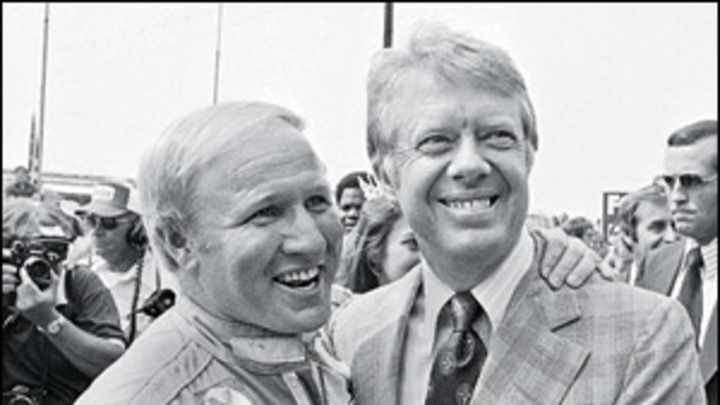Daytona 50 Years

This was the golden age, an era graced by some of the most memorable stars and cars in NASCAR history and defined by some of the fiercest rivalries the sport has known. The King's reign continued -- Richard Petty won 89 races and five series titles during the decade -- but it wasn't easy. He tradedpaint weekly with such legends as Bobby Allison, Benny Parsons, David Pearson and Cale Yarborough, men who were stars in their own right and who beat him with remarkable regularity, especially Pearson. The second-winningest driver in NASCAR history, the Silver Fox is remembered fondly by fans for besting his nemesis at the wire of the 1976 Daytona 500, when a final-lap accident between the two drivers left Petty stuck in the infield while Pearson literally coasted to the win. Racing had never been more exciting.
And the stakes had certainly never been higher. In 1971, a year after Congress banned the advertising of cigarettes on television, tobacco giant R.J. Reynolds found a new way to continue its television presence by taking over sponsorship of the Grand National circuit, which it renamed the Winston Cup. Suddenly energized by RJR's Madison Avenue marketing strategies, as well as by an infusion of cash, NASCAR began to grow beyond its Southeastern roots. By 1979, when CBS went live from the Daytona 500 with flag-to-flag coverage (the first such broadcast in NASCAR's history), the sport could no longer be considered just a regional pastime. It had become a thoroughly American institution.
1970 - The same year Buddy Baker becomes the first driver to top 200 mph in a stock car during a test run, Pete Hamilton's 149.601-mph average is enough for a Daytona 500 victory. For the little-known Hamilton -- the beneficiary of car trouble among the favorites -- it is the first of four races he will win in his brief career.
1971 - Petty Enterprises has quite the day: Team member Baker finishes second and is one of only two drivers to finish on the lead lap behind Richard Petty, who wins his third 500.
1972 - Halfway through his 40-year racing career, open-wheel legend A.J. Foyt wins his first -- and only -- Daytona 500.
1973 - Petty and Baker are neck and neck in a two-car race until Lap 195, when Baker's engine blows. Driving a Dodge after winning three previous times in a Plymouth, Petty cruises to a two-lap triumph, still the widest margin of victory in race history.
1974 - Call it the Daytona 450; because of an energy crisis, the length of the race is cut back 10%. That's no calamity for Petty, who wins his third Daytona in four seasons and becomes the first driver to win back-to-back starts in the Great American Race.
1975 - Benny Parsons chases David Pearson for most of the race until Pearson suffers a spinout. Parsons holds the lead for only four laps, but four is all it takes: The future broadcaster leads the fewest laps by a 500 winner, winning over Bobby Allison and Cale Yarborough.
1976 - A crash involving leaders Petty and Pearson on the last lap appears to finish both cars, but while Petty sits on the grass, unable to restart his engine, Pearson rolls across the finish line to win.
1977 - When the grand marshal proclaims, "Lady and gentlemen, start your engines," fans boo Janet Guthrie, the first woman to qualify for the 500. Cheers erupt, though, when she finishes in a respectable 12th place, behind winner Yarborough.
1978 - Working his way up from 33rd place to take the first of his three checkered flags at the 500, Bobby Allison overcomes the then lowest starting position by an eventual winner. The win ends Allison's 67-race winless streak.
1979 - A fistfight erupts on the infield after Yarborough and Donnie Allison, battling for the lead, crash on the last lap, allowing Petty to win. With their wrecked cars sitting on the grass, Yarborough and Allison begin arguing about who's to blame for the collision. The fists start to fly when Bobby Allison, whose car has been lapped, pulls over to defend his brother.
